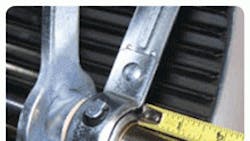It has become a cliché to say that something "isn't rocket science," but that truly is the case with evaporative coolers. These units represent probably the simplest way to cool a space. And yet, incorrect installation and service procedures can still take their toll on the performance and reliability of these relatively simple cooling units.
To assist you in your troubleshooting of an evaporative cooling unit on a service call, it’s helpful to know the proper installation procedures, so you can see if the unit was set up correctly in the first place. Check to make sure the following installation procedures were followed, as most service problems stem from a bad installation.
For ducted coolers that have variable sheaves, the sheave settings should be set to the motor nameplate amps. Make sure exhaust ducting is available when setting motor amps; there should be approximately 2 sq.ft. of exhaust for every 1,000 cfm the cooler produces.
The water supply line to the cooler float should be ¼-in. copper tubing, and this line must be secured. Unsecured water lines can set up water hammering from the cooler all the way down to the shut-off valve.
Evaporative coolers should be connected to a dedicated and properly fused electric supply line.
To block off ductwork during a winter shutdown, a ductwork riser with a removable damper should have been installed between the cooler and the roof.
The Service Call
After you have verified proper installation, you can begin your service call. Inspect the cooling media (often called "aspen media") and the media's frame to ensure that there aren't any voids that could cause water entrainment.
Next, check the unit’s belt tension. Grab both sides of belt approximately 6-in. to 8-in. away from the motor sheave (pulley). A properly tensioned belt should deflect about ½-in. in both directions.
Finally, when lubricating the blower wheel's sleeve bearings, be sure to use only a 20 weight non-detergent oil. It's very important to use a non-detergent oil in this application
Troubleshooting Tips
If you're running a service call on an evaporative cooler, check these aspects of the unit before calling the manufacturer's tech support line. These nine tips will help you solve the vast majority of problems with residential or commercial evaporative coolers:
1. The motor "hums" but doesn't run at start up: the motor is stuck in start windings (windings are open) or the motor is defective.
2. The motor won't run in high or low speed: the windings are open or the motor is defective.
3. The motor won't start at all: the motor is defective.
4. The recirculating pump is not operating: remove the pump from the cooler and plug it into another outlet. If it still doesn't operate, the pump is defective.
5. The recirculating pump is not flowing to full capacity: remove the pump from the cooler, remove the cleanout disc at the bottom of pump (if the pump is so equipped) and check for any blockage, such as cooling media debris or calcium. Clean or replace the screen that's attached to the pump assembly.
6. Water deposits are accumulated on the pulley and bearing: check for any voids in the cooling media. Do not allow the media to become covered with calcium that will block airflow or create voids that will allow water entrainment. Make sure the media is tucked above the unit's V trough; if it's not, water will flow inward in the airstream without wetting the media pad and will cause water entrainment.
7. Make sure the motor is appropriate for the cooler. Don't use a larger horsepower motor than the cooler was design for. Use only the blower motor and circulating pump combinations that are suitable for the cooler; these will be marked on the unit's nameplate. Additional airflow will cause water entrainment.
8. A musty or unpleasant odor enters through the ductwork: drain and flush the reservoir. Reservoir water can become musty if a cooler has not been operating daily.
Finally, don't use anodes or chemical additives or treatments to remove solids that come from water evaporation. Follow the cooler manufacturer's recommendation for manual bleed-off or purchase a drain pump that removes solids while the cooler is operating.
Troubleshooting Industrial Applications
Large evaporative coolers used in industrial applications have a few additional areas you’ll want to check on your service calls.
If the blower seems to be operating out of round, check the eccentric collar that is attached to bearing inner race collar. If the eccentric collar is loose or not attached, reattach it to the inner race collar by rotating the eccentric collar in the direction of airflow, and then tightening the set screw.
When setting the motor to nameplate amps, make sure there is adequate relief exhaust (2 sq ft. of exhaust for every 1,000 cfm the motor produces). If the motor cycles off and on, check the sheave adjustment.
If an industrial motor can't be adjusted to nameplate amps, determine if the correct sheave is in place for the application. Note that some applications require rpm settings to be made at certain static pressures. Higher rpms at some static pressures when the motor is set to nameplate amps will cause water entrainment.
When sizing a cooler application and external static pressure is not given, size the application for 0 static pressure. Use the rpm for 0 static and determine which sheave will operate at that rpm.
Make sure the float supply line is secure, otherwise it will cause water hammering. If water is draining over the standpipe, readjust the float. Allow space just below standpipe height so that when the pump shuts off there’s enough room for the water that will drain from the cooling media.
Paul Benich is warranty manager, Phoenix Manufacturing Inc., Phoenix, AZ. He can be reached at 602/345-3715, toll-free 800/325-6952, or by e-mail at [email protected]
